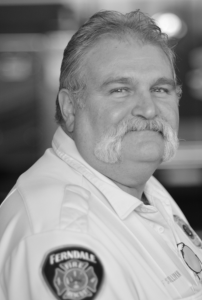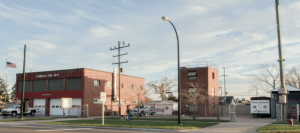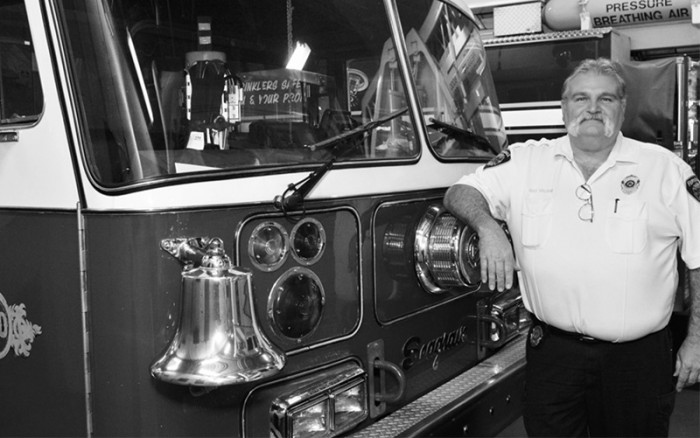Blaze of Glory: A behind the scenes look at your Ferndale Fire Department
Story by Sherrad Glosson | Photos by Bernie LaFramboise
Going head to head with a fire is something most of us can’t imagine. The closest most of us have been to great heat is either from our range, bonfires with friends, or the blazing sun in the middle of July. That’s pretty hot, but can you imagine running into a burning building (instead of out, as fast as you can) with lives resting on your every decision? That’s a job only the brave can handle. This is why we admire firefighters.
But what about the rest of the day? When there isn’t a fire, do they just sit and wait until the phone rings? What’s it really like to have this job, day in and day out? Ferndale Friends decided to stop by the Ferndale fire department to speak to the head honcho, Chief Kevin Sullivan, to find out firsthand.
 The building was quiet when I walked in. The garage was filled with trucks, silent and gleaming. I was in luck, as the chief was there and had a few minutes to talk to me.
The building was quiet when I walked in. The garage was filled with trucks, silent and gleaming. I was in luck, as the chief was there and had a few minutes to talk to me.
On the way to his office, we walked up two flights of stairs. To the left of me was a full kitchen. I thought about that as we walked through two glass doors and there he was, sitting at a desk with a ton of papers in front of him.
The first thing that came out of my mouth was, “So, we all know that the fire department is known for putting out fires, but what are you guys doing when there isn’t a fire happening?” Chief Sullivan laid it out for me.
In today’s world, the fire department is known for being an emergency response unit. Generally speaking, anything the police doesn’t handle, the fire department does. They have five different branches of technical rescue units: 1. Heavy rescue (for when people are caught in machines or bad car accidents where they would use the “jaws of life”), 2. High angle and low angle (which is rope work, lowering someone off a tall building), 3. Confined space (usually underground, where someone is trapped), 4. Collapse rescue (people digging trenches and foundations, or erecting buildings), 5. Swift water rescue (mostly when someone is injured in a pool and they help to get them out).
There is always someone at the station. The firefighters work 24 hours on and 24 hours off, sometimes doing 70 to 80 hours of duty weekly. They have someone who is designated to cook lunch and dinner (this explains the kitchen.) Chief Sullivan joked that the food must be edible or you pay the price. Every day of the in-between time there’s training, such as technical rescue education. There’s the unglamorous stuff, like inspecting fire hydrants, making sure they don’t freeze during the winter months. Every Monday, they do a motor check on the equipment to make sure everything is always ready to go.
 They cover three cities, including Ferndale, Royal Oak Township, and Pleasant Ridge, operating from two stations, one on either side of Woodward. Although the station on Livernois is the headquarters (the other is on 9 Mile east of Hilton,) both stations aid each other and are sure to have each other’s back when there is a big emergency. There are a total of six firefighters on duty in the whole city, four in the headquarters and two in the other station. “Back in the day it used to be about ten, but times are different now.” said the Chief.
They cover three cities, including Ferndale, Royal Oak Township, and Pleasant Ridge, operating from two stations, one on either side of Woodward. Although the station on Livernois is the headquarters (the other is on 9 Mile east of Hilton,) both stations aid each other and are sure to have each other’s back when there is a big emergency. There are a total of six firefighters on duty in the whole city, four in the headquarters and two in the other station. “Back in the day it used to be about ten, but times are different now.” said the Chief.
I asked the Chief about how long he’s been a firefighter and how he got involved. “I’ve been a fire fighter going on 31 years. My dad was a cop, but there was no way I was going to do that, and firefighting was the next best thing.” Chief Sullivan has been in his position for six years, and worked his way up through the ranks.
I asked him about the causes of fires. “Human error is what causes most fires,” the Chief explained. “Leaving the dishwasher on when you leave for work, lighting a candle without a plate under it and leaving it unattended…some fires are started because people don’t clean out the lint trap on the dryer and it catches fire, and even parking on top of leaves on the curb.” A car’s catalytic converter gets hot, and with its location underneath the car, it can touch the leaves and easily set them ablaze. “We don’t think about these things… because we feel like it will never happen to us,” said the Chief. “Everything in our society is plastic, and it’s like solidified gasoline. When it melts, it burns ten times faster and a hundred times better than it did in the old days.” Oh, and watch out, because the Chief said that he can easily tell if there was any foul play involved in the fire’s ignition.
After our discussion, we went on a tour around the station. Quiet again. Where was everyone? Well, Chief Sullivan explained, they were out on site helping someone. Not only do they stop fires, but they are here to help aid anyone in any way they can. Even when there isn’t a fire, they aren’t sitting around watching television. They’re making sure that they’re up to date in their knowledge, training, and awareness so that they are always dependable and reliable when help is needed. Firefighters are always preparing themselves for the hour, the minute, and the second someone calls for help. We all hope that day never comes, but if it does, the firefighters of Ferndale are ready to roll.
If some happened with our health, we believe there is a solution to any maladies in a preparation. What medicines do patients purchase online? Viagra which is used to treat impotency and other states connected to erectile disfunction. Learn more about “sildenafil“. What people talk about “viagra stories“? The most substantial aspect you should look for is “sildenafil citrate“. Such problems commonly signal other problems: low libido or erectile disfunction can be the symptom a strong health problem such as soul trouble. Causes of sexual dysfunction turn on injury to the penis. Chronic disease, several medicaments, and a condition called Peyronie’s disease can also cause sexual dysfunction. Even though this medicine is not for use in women, it is not known whether this curing passes into breast milk.



